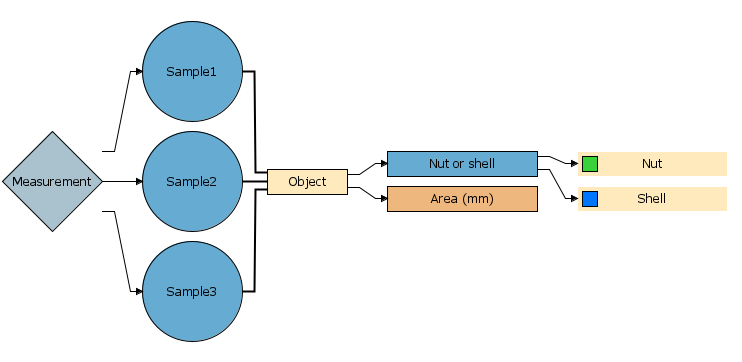Segment objects from measurements using intensities in the different bands/wavelengths
Parameters
Convert to
If the spectral data should be converted before applying the expression. Learn more inChanging spectra. No conversion will be made if the data already is the same format.
Expression
Write expression. Band numbers are denoted b[N] e.g. b1 and wavelengths are denoted w[nm] e.g. w1200. The following comparators can be used for the expression:
Operators than can be used expressions include the data operators wNNN and bMMM for referring to wavelength bands, the range operator : used for averaging data, standard arithmetic (+,-,/,* …) and comparison operators (=,>,< …) as well as some mathematical functions (
…) and constants (
).
Breeze does not validate the provided expression until you click Apply changes to apply it to some data.
|
Data Operator |
Description |
|---|---|
|
|
Wavelength lookup operator that finds the wavelength band closest to the provided number A setting controls how far off a wavelength is allowed to be to be considered a match. If there isn’t matching data an error is displayed when applying the workflow to data. Learn more in Wavelength matching. Example of this syntax: |
|
|
Band index operator. If the index |
|
|
Average range operator that returns the average value for a range of wavelength bands. For example: |
Variable names that can be used in the expression:
-
MinValue -
MaxValue -
AvarageValue
Pretreatments
In top-down applied order ⬇️ , meaning Savitzky-Golay is applied first then Derivative and so on.
-
Savitzky-Golay
-
Derivative
-
SNV (Standard Normal Variate)
-
Logarithm
-
Center
-
UV (Unit Variance) scaling
For more on each type of pretreatment see: Pretreatments
Min area
The minimum number of pixels for an object to be included.
Max area
The maximum number of pixels for an object to be included.
If 0 no maximum area is defined.
Object filter
Use an expression to further exclude unwanted objects based on shape.
Properties that can be used for the Expression:
-
Area -
Length -
Width -
Circumference -
Regularity -
Roundness -
Angle -
D1 -
D2 -
X -
Y -
MaxBorderDistance -
BoundingBoxArea
For details on each available property see: Object properties Details
Shrink
Takes away x numbers of pixels at the borders of the objects included in images.
Separate
-
Normal
-
Can have both separated and combined objects.
-
-
Separate adjacent objects
-
All objects are defined separately.
-
-
Merge all objects into one
-
All objects are defined as one.
-
-
Merge all objects per row
-
All objects per row segmentation are defined as one.
-
-
Merge all objects per column
-
All objects per column segmentation are defined as one.
-
Link
Only visible when applicable
Link output objects from two or more segmentations to top segmentation. Descriptors can then be added to the common object output and will be calculated for objects from all segmentations.

The segmentations must be at same level to be available for linking.
Example
Using band numbers
Expression: (b10 > 1.5 | b15 < 2) & b20 <= 1.2
Using wavelengths
Expression: (w980 > 1.5 | w1024 < 2) & w1200 <= 1.2
Use variables for the expression
Expression: w980 > AvarageValue
